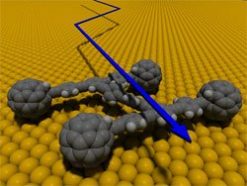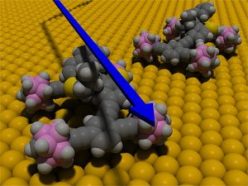Atomic Drive
Chemists have assembled atoms into tiny molecular cars that motor across a gold surface.
By Emily Sohn
Trucks, tractors, and bulldozers are impressive machines. They can rip into the earth or carry tons of gear. Large vans line the streets of many neighborhoods in the United States. Meanwhile, everyday automobiles seem to be getting bigger and bigger.
A new wave of vehicles, however, is pushing a different kind of size limit. Called nanocars, these dream machines are practically invisible.
 |
|
These two nanocars have rotating motors that move the cars forward. |
| Yasuhiro Shirai/Rice University |
Made of 169 atoms, each car is a single molecule that measures just 3 nanometers wide and 4 nanometers long. One nanometer is equal to one-billionth of a meter. It would take about 20,000 nanocars in single file to span the width of a human hair.
Scientists at Rice University in Houston, Texas, announced their invention of nanocars last October. More recently, the scientists added miniature motors to their machines. The same research group, led by chemist James Tour, previously produced NanoKids—molecules that look vaguely like human figures (see “The Incredible Shrunken Kids”).
NanoKids (if they were old enough) could probably drive nanocars, but that’s not the purpose of these wee automobiles. Someday, nanocars might help boost the efficiency of atomic-scale construction projects, such as the building of computer chips. Some of these tiny vehicles might work as medical submarines, probing our bodies for disease.
Starting small
Tour’s inspiration came from thinking about how nature builds things—from the bottom up. In other words, nature starts small and gets bigger. Trees, for example, begin life as seeds, and they add cells as they grow.
On the other hand, when people build things, they usually work in the opposite direction. “People generally construct from the top down,” Tour says. “If you want to build a table, you cut down a big tree [for the wood] to make it.”
Even when scientists construct molecules, they generally use large machines to nudge each atom into place. Nanocars, Tour thought, might be a better way to pick up atoms and move them around.
To understand his reasoning, think about termites. Each termite is tiny, but a large group of these insects can work together to build huge mounds of dirt. Nanocars, likewise, might be able to team up and construct intricate objects.
Rolling molecules
It took 5 years of hard work to make a nanocar that could roll, Tour says.
The scientists used carbon and other common elements to make a platformlike frame and axles for holding the wheels. Each wheel was a molecule called buckminsterfullerene, which consists of 60 carbon atoms arranged in a pattern that looks like the surface of a soccer ball.
After they’d manufactured the nanocars, the researchers used a special microscope to show that each nanocar actually works likes a car—that it rolls forward and backward on four wheels in a direction at right angles to its axles, rather than sliding about like a car on ice.
Tour’s group then turned to the next challenge: adding a motor.
 |
|
These two nanocars have rotating motors that move the cars forward. |
| Yasuhiro Shirai/Rice University |
Starting with a molecular framework developed by scientists in the Netherlands, Tour’s team created a rotating motor for the car. When the experimenters shone a specific wavelength of ultraviolet light on the motor, it spun like a paddlewheel and pushed the car forward along a gold surface.
Next, Tour wants to make nanocars that can pick up and transport objects.
Heroic chemistry
Tour is optimistic about the technology’s potential. “It’s important for children to appreciate this because, in 40 or 50 years, this technology is going to begin to take off,” he says.
At this point, applications seem less important than the achievement itself, says materials scientist Ray Baughman. He directs the NanoTech Institute at the University of Texas at Dallas.
“Even the idea of making a molecule that can roll like a car on a surface is exciting,” Baughman says. “But to actually do it is remarkable. This is heroic chemistry.”
Going Deeper:







